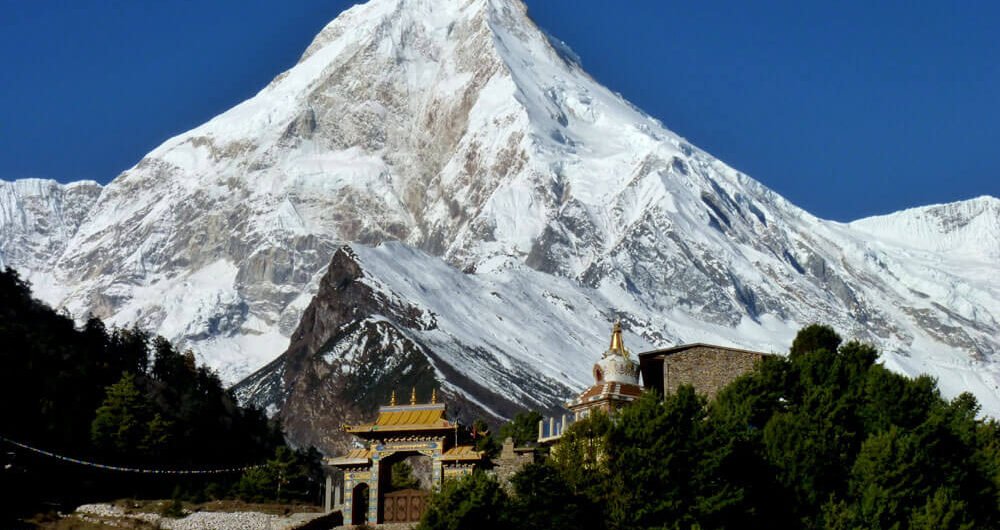Tsum Valley Trek, located in the northern part of the Gorkha district of Nepal, is a sacred Himalayan pilgrimage valley. It is nestled against the backdrop of the majestic Ganesh Himal, Sringi Himal, and Boudha ranges. The valley was a restricted region until it was opened for trekking in 2008, preserving its rich cultural heritage and traditions.
Historically, Tsum Valley was part of the Tibetan territory and has retained a strong Tibetan influence. The people of Tsum, known as Tsumbas, practice Buddhism and have a unique dialect, culture, and customs distinct from other parts of Nepal. The valley is known for its ancient monasteries, meditation caves, and centuries-old stupas and mani walls. Tsum Valley Trek has now become one of the most loved trek across world.
Note – > We advise to accompany yourself with an experience guide who know the entire route of Tsum Valley Trek.
Tsum Valley Trek Detailed Itinerary
Day 1: Arrival in Kathmandu
Explore the vibrant streets of Thamel.
Visit UNESCO World Heritage Sites like Swayambhunath (Monkey Temple) and Pashupatinath.
Day 2: Kathmandu to Soti Khola (700m)
Travel to Soti Khola, the launch point for your trekking expedition.
Travel to Soti Khola, where your trekking adventure begins.
Day 3: Journey on foot from Soti Khola to Machha Khola, ascending to an elevation of 869 meters.
Day 4: Machha Khola to Jagat (1,340m)
Cross suspension bridges, walk along riverbanks, and pass through the village of Tatopani, known for its hot springs.
Day 5: Jagat to Lokpa (2,040m)
Enter the restricted area and climb through rhododendron forests.
Day 6: Lokpa to Chumling (2,386m)
Trek through lush forests and enjoy stunning views of the Ganesh Himal.
Day 7: Chumling to Chhokangparo (3,031m)
Pass through traditional villages and get a glimpse of local life.
Day 8: Chhokangparo to Nile (3,361m)
Visit the Milarepa Cave, where the famous Tibetan saint Milarepa meditated.
Day 9: Nile to Mu Gompa (3,700m)
Reach the highest point of the trek, Mu Gompa, and explore the ancient monastery.
Day 10: Mu Gompa Exploration
Spend a day exploring the surroundings and visiting the Dhephu Doma Gompa.
Day 11: Mu Gompa to Rachen Gompa (3,240m)
Visit Rachen Gompa, known for its intricate murals and Buddhist texts.
Day 12: Rachen Gompa to Chumje (3,230m)
Descend through the valley and visit small monasteries and villages.
Day 13: Chumje to Bihi Phedi (2,130m)
Trek back towards the lower region of the valley.
Day 14: Bihi Phedi to Philim (1,570m)
Enjoy the scenic landscapes and terraced fields.
Day 15: Philim to Khorlabesi (970m)
Continue descending and crossing multiple suspension bridges.
Day 16: Khorlabesi to Soti Khola
Reach the starting point of the trek.
Day 17: Soti Khola to Kathmandu
Drive back to Kathmandu and enjoy a farewell dinner.
Day 18: Departure
Proceed to the airport for your onward travel arrangements.
Along with Tsum Valley Trek, one can also visit near by Key Attractions and Cultural Heritage
1. Mu Gompa
History: Established in the 19th century, it is the largest monastery in the region.
Significance: It serves as a major center for Buddhist studies and meditation.
2. Rachen Gompa
History: Built in 1905, it is an important nunnery.
Significance: Known for its beautiful murals and ancient texts, it provides insight into Tibetan Buddhism.
3. Milarepa Cave
History: Associated with the legendary Tibetan saint Milarepa, who meditated here.
Significance: A pilgrimage site for Buddhists, it offers spiritual significance and serene surroundings.
4. Dhephu Doma Gompa
History: A newer monastery but significant for its cultural and educational role.
Significance: Houses several monks and serves as a center for learning.
Nearby Attractions to Tsum Valley
1. Manaslu Circuit Trek
Details: This renowned trekking route provides breathtaking views of Mount Manaslu, the world’s eighth highest peak
Significance: Combines natural beauty with rich cultural experiences.
2. Ganesh Himal Base Camp
Details: A trek that provides an up-close view of the Ganesh Himal range.
Significance: Known for its diverse flora and fauna, as well as its beautiful landscapes.
3. Gumba Lungdang
History: A remote monastery with a small community of nuns.
Significance: Offers a peaceful retreat and panoramic views of the surrounding peaks.
4. Sringi Himal Base Camp
Details: A lesser-known trek that leads to the base of Sringi Himal.
Significance: Perfect for those seeking solitude and pristine nature.
Conclusion
Tsum Valley is a hidden treasure in the Himalayas, combining breathtaking natural beauty, rich cultural heritage, and profound spiritual tranquility. Its isolation has helped preserve its unique traditions, making it a must-visit for those seeking an off-the-beaten-path adventure. Whether you’re trekking through ancient forests, exploring sacred monasteries, or simply soaking in the tranquility of the valley, Tsum Valley promises an unforgettable journey.
Official Nepal Tourism Website – -> https://ntb.gov.np/
To know more about the trek – Call us @ +91-9910656940
